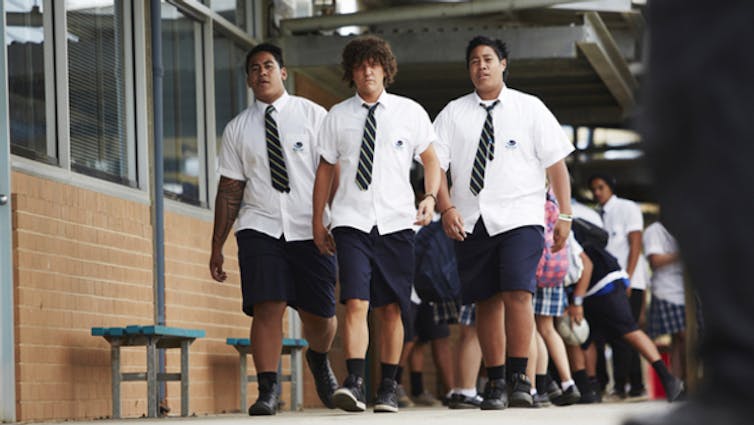The idea of a generation gap is an old one, but the discrepancies between young people’s lived experience and other people’s perceptions present a very contemporary challenge. Today The Conversation begins a series, Another Country: Youth in Australia, which considers key aspects of being a young Australian and the consequences of public misrepresentations, ignorance or indifference for the nation’s future.
If you have been listening to certain politicians you may be gripped by the rising tide of panic about a younger generation who – apparently – threaten the very fabric of our society.
Young Australians are lazy, narcissistic and dishonest. They do not do what they are told. They are slackers, sponges and bludgers who are – apparently – unable and unwilling to get or hold down a job.
They cannot spell. They cannot read or write. They cannot name the capital of this country. They wear their pants hanging down around their arses, their undies on the outside and are always blasting crappy music through their earphones as they tweet #yoloswag.
This younger generation has been profiled in bestselling works such as The Narcissism Epidemic (subtitle Living in the Age of Entitlement) and The Dumbest Generation. These books argue that they suffer from a seeming inability to understand complex ideas or make rational judgements.
Today’s youth are characterised by apathy and political disinterest. They occupy a twilight world defined by Instagram and hashtags. They are only interested in themselves – hence, their signature gesture is the selfie.
Worst of all, they are said to be darkening our world with an epidemic of misbehaviour. When they are not binge drinking or taking drugs, they are murdering each other – or innocent passers-by – with king hits and coward punches. Society is forced to retaliate with lockouts and curfews – or a popular commercial alternative such as the Mosquito alarm, badged by European civil liberties groups as a form of sonic torture for under 25s.
These are the generational stereotypes informing our responses to some of the most pressing social problems of our age, including youth unemployment, homelessness, mental illness and suicide.
It is the kind of thinking that allowed the recent federal budget to single out a section of the population for special attention and to dismantle a universal welfare safety net in a manner that would have been unthinkable 20 years ago – not even as punishment for the alleged misdemeanours of my own so-called Generation X.
Unloved but ‘in love with themselves’
Only a few days after the budget, much of the media returned to generation bashing as usual. The ABC’s All in the Mind declared:
Research says young people today are more narcissistic than ever.
This was a rehash of some questionable American research that has been recycled in Australian media for several years now. It has previously appeared, for example, in the Sydney Morning Herald as “New generation infected by narcissism, says psychologist” and “Gen Y are selfish lazy narcissists”, and in The Age as “Is this the most narcissistic generation we’ve ever seen?”
The budget coincided with the launch of I Want To Marry Harry. This is the most recent offering in a long line of reality TV shows designed to take advantage of young people’s emotional immaturity for the enjoyment of mostly adult audiences, who are encouraged to feel a sense of superiority.
Earlier in the year, Channel 7 made the point more explicitly, launching the first series of Young, Lazy and Driving You Crazy (a spin-off of the successful UK series Young, Dumb and Living Off Mum). Alleged underachievers are inserted into a range of stitched-up scenarios in which they compete with each other to say ridiculous and offensive things. Why? Because basically they are appearing in a reality TV show and this behaviour is expected of them.
But the most astonishing offering of the budget weeks was Chris Lilley’s Jonah from Tonga. Here is a program that features an almost 40-year-old man masquerading as a 14-year-old Tongan boy, replete with brown make-up, curly wig, fake tatatau and a repertoire of obscene and thuggish gestures. The Tongan and Polynesian communities have mounted a social media campaign My Name is Not Jonah to make the point that these culturally and generationally cross-dressed charades are both racist and creepy.
As one critic put it:
The fact that Lilley can win praise for racial cross-dressing might be the best satire of Australian racism.
He did not mean this as a compliment.

It is noticeable that much of the humour in Jonah – and Lilley’s previous blackface, brownface and yellowface creations, as well as the ludicrously narcissistic Ja’mie – lies in the way that the young characters’ dialogue so often mimics that of the adult characters around them.
I’m going to work hard, says Jonah, be smart, go to university – as he welds children into footlockers and forces young boys to eat dog shit. The intended audience is meant to fall around laughing – apparently thinking never in a million years, because Jonah is “mentally defective”, as the adult characters around him say, and a “fuckwit”.
Once again, the humour depends on allowing a mostly adult audience to feel a sense of superiority. The racial stereotypes manufactured in Jonah are apparently less visible to adult audiences because they are wrapped in a pre-existing set of generational prejudices. These programs tell us nothing about the younger generation and everything about the adults who make them.
Attitudes shape actions
The two-dimensional portrayal of young people in the media is of increasing concern because the way in which young people are represented appears to be contributing to how they are treated.
Somehow the idea that young people might have problems has, as Henry Giroux has so often pointed out, mutated into a prevailing belief that young people are the problem. Society disinvests, education is defunded, institutions abandon civic responsibilities, class divides harden, charities struggle to meet the flood of needy demand – and governments move their considerable resources into police, prisons and punishment.
Young people were once characterised by the idea of innocence and hope for the future. They were — so, for example, the Anzac myth went — the best and the brightest, embodying the “destiny of the nation”.
This quaint-sounding idealisation of youth was in many ways a product of a previous century’s belief in progress. The myth was often at odds with grim realities, which, for example, included child labour and poverty. Nevertheless, the idealisation of youth arguably helped to engender a progressive tendency that contributed to the eradication of social problems.
In our own century this idea of progress has imploded, to be replaced by the image of a future in ruins. In this vision, the future is filled not with promise, but with uncertainty.
Accordingly, young people have ceased to be represented as a repository for our brightest hopes, but as the embodiment of our darkest fears. Culturally, they are condemned to eke out a marginal existence. They are uneconomic propositions in an economically minded society that fails to measure compassion, hope or social justice.
No longer understood as a resource for the future, young people are deemed to be unworthy of social rights – not even, as the budget demonstrated, Newstart allowances. They are represented as parasites on the adult world. They are deemed to be, as Zygmunt Baumen has argued, a disposable generation.
See the rest of the Another Country: Youth in Australia series here.

